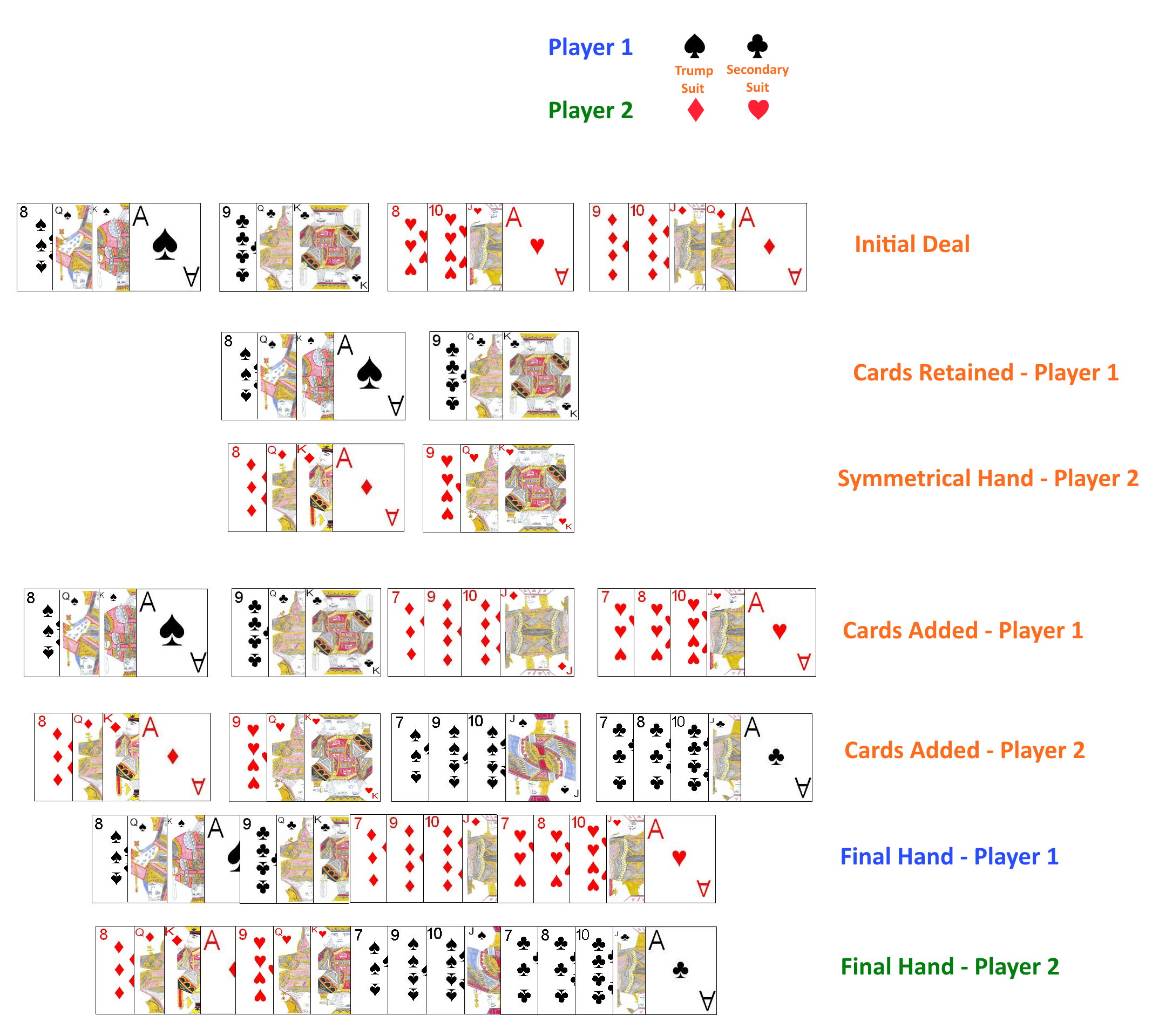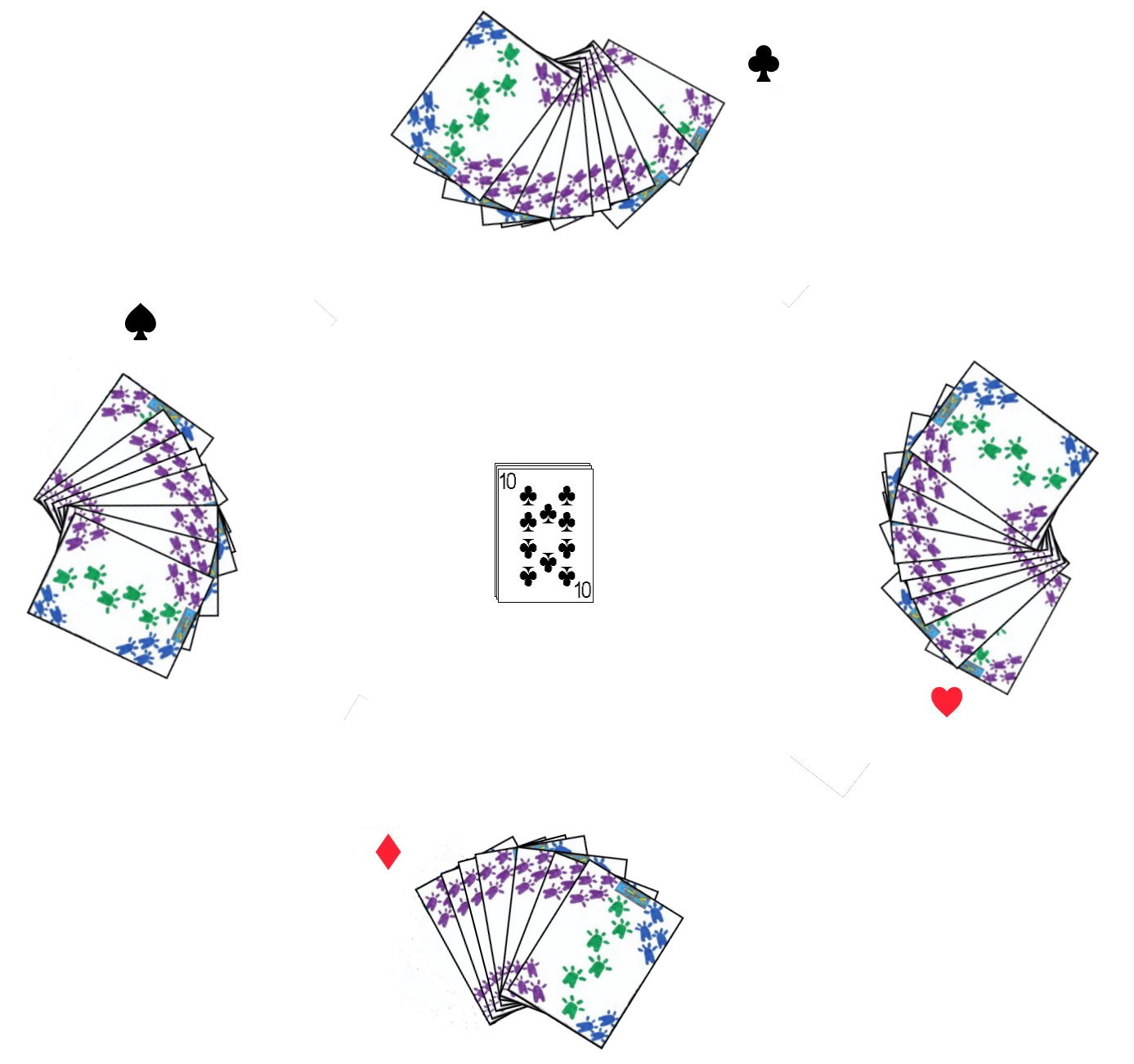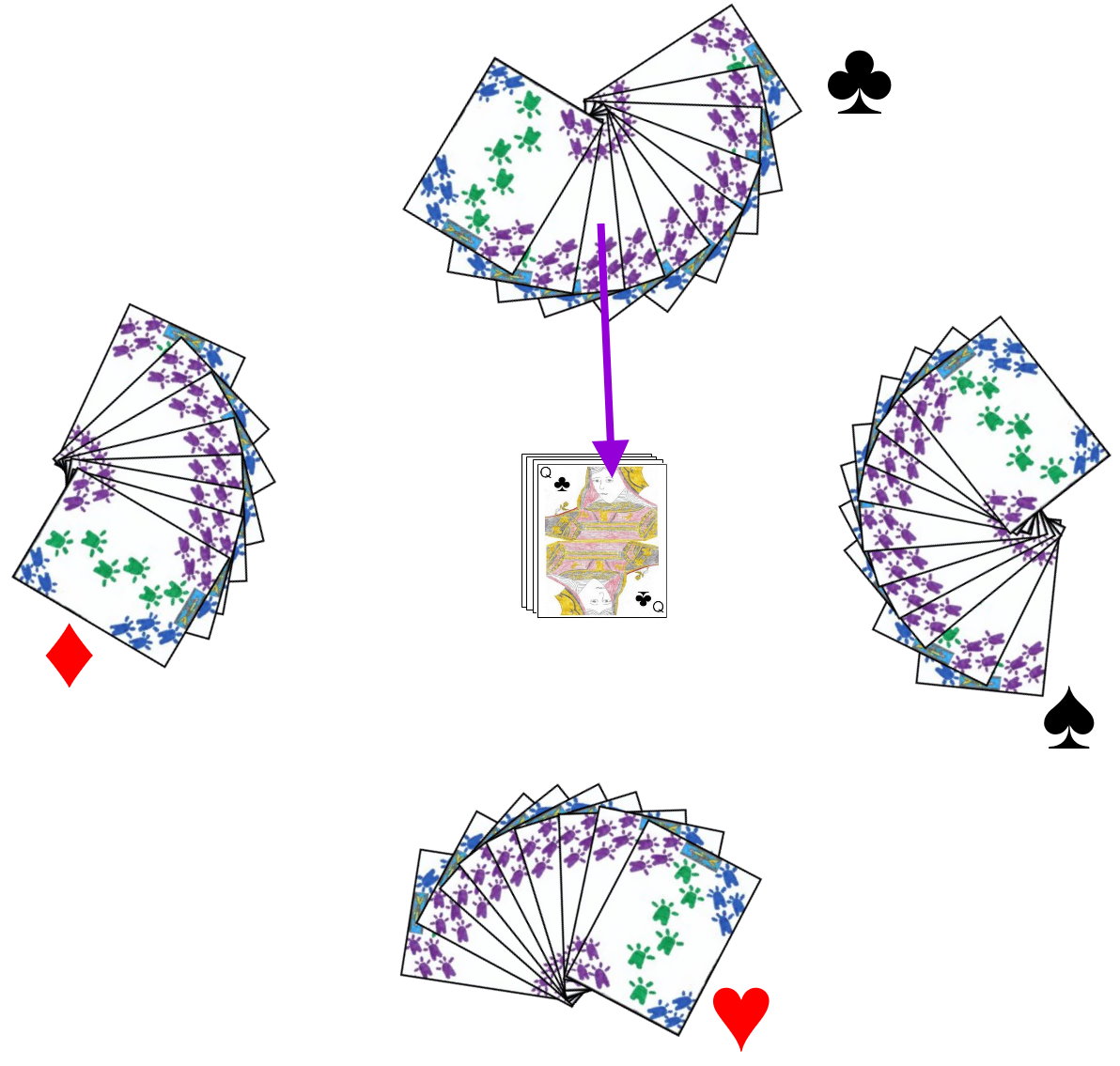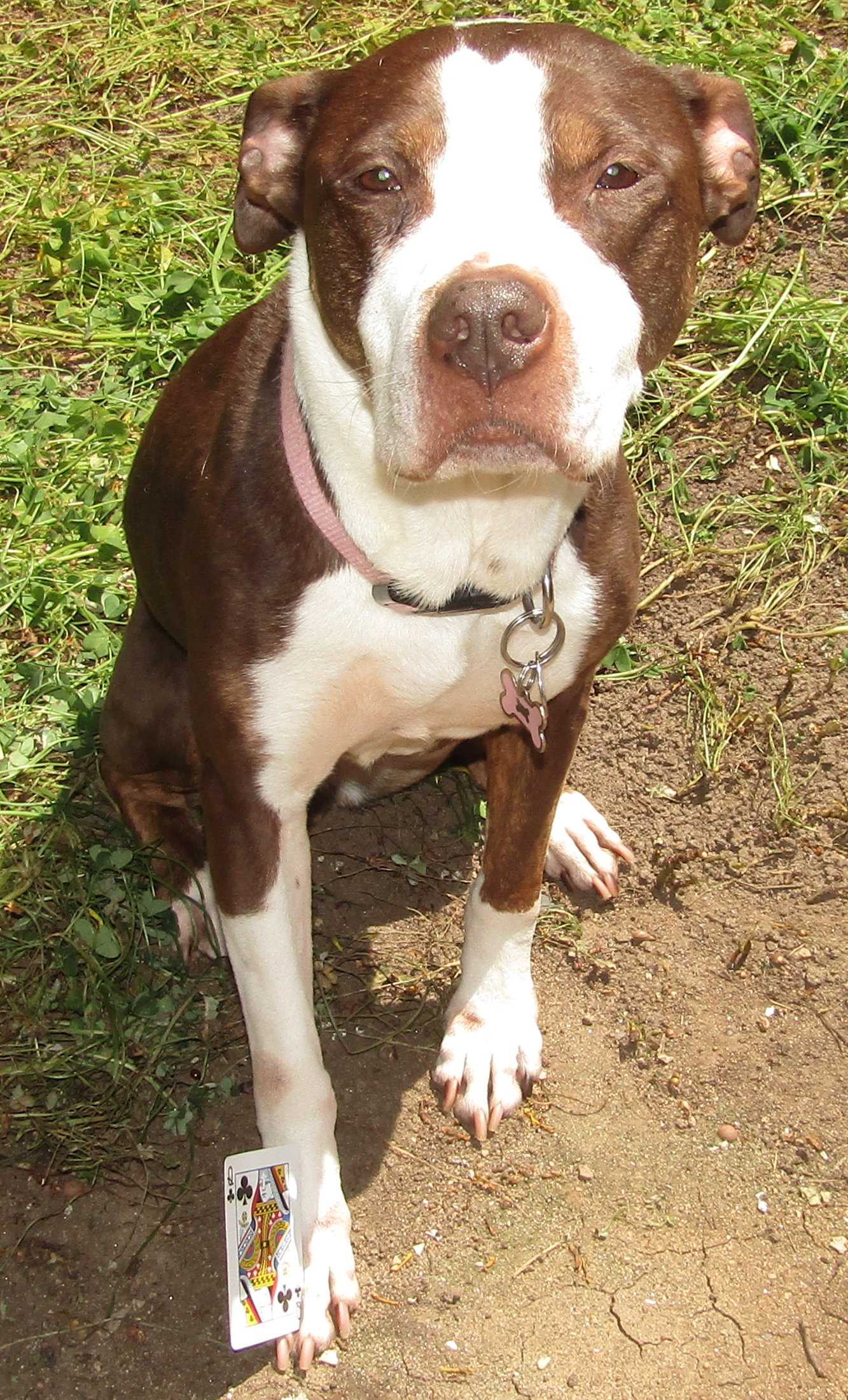Svoyi Kozyri is a Russian card game from the "beating" family of card games in which players race to attempt to be the first to completely rid his hand of all cards. There are various versions of this game which can be found, but one of the most unique is the two player variant which will thus be described first. This variant of the game was brought to Cambridge University in the early 1920's by Professor Abram Samoilovitch Besicovitch. It gained some popularity in the 1960's under the name Challenge when the rules for the game were published in a card game book by Hubert Phillips. Variants of the game for three or more players are detailed further below. This variant is also known with the slightly different spellings of Svoyi Koziri or Vsyak Svoi Kozyri.
What makes the two player game unique is the fact that this version is a game of perfect information, meaning that each player knows exactly the entire contents of his own and his opponent's hand throughout the entire game.
The standard two player variant uses a standard Skat deck, which consists of a deck with four cards in each of the following denominations 7, 8, 9, 10, Jack, Queen, King, Ace, one card of each denomination in each of the four standard suits. The ranking of the cards in this deck are as follows (from high to low): Ace, King, Queen, Jack, 10, 9, 8, 7.
A number of methods can be used to determine the first dealer, with cutting for high card a common method. In this method, each player cuts a card from the shuffled deck and the player drawing the higher card (using the card ranking as described above) set as the first dealer. If both players draw cards of the same ranking, both players should draw new cards. If the next cards are also equally ranked, the players should repeat this procedure, continuing until one of the cards drawn is of a higher ranking. After each hand the role of dealer should alternate amongst the two players.

In order to maintain the aspect of perfect information in the game, the game consists of a special initial setup and dealing procedure. This begins with the dealer selecting any suit as his trump suit. He then selects any one other suit as a secondary suit. The other player then selects one of the two remaining suits as his trump suit and the other remaining suit is set as his secondary suit. After the players have selected suits, the dealer then deals the top 16 cards from the deck face-up in a row on the table. From this row of cards he removes all cards in his selected suits, adding them to a face-up stack which will eventually become his hand for the game. He places the remainder of the original dealt cards back into the stock. The opponent of the dealer then shuffles through the stock pile and begins creating his own hand based on the cards that currently comprise the dealer's hand. Thus, for each card the dealer found in his trump suit, the dealer's opponent should then find the corresponding card, in the same rank, in his own trump suit and adds this to his own hand. Similarly, for each card the dealer currently has from his secondary deck for his hand, the dealer's opponent should find those same cards in his secondary suit, adding them to his own hand. From the remaining stock, the dealer then takes all cards still in the stock of his opponents trump suit and secondary suit. The remaining cards, which should all be of the dealer's trump and secondary suits, should then be given to the dealer's opponent. The final result is that both players should have a hand that is exactly symmetrically equivalent to the other player.
After the hands have been created in this way, each player should lay his hand face-up in front of himself, such that the both he and his opponent can clearly see each hand. The dealer begins the game with the first play (leads to the first trick), which is played out in a series of tricks.
The leader of a trick may play any card from his hand to start each trick. His opponent then has two options:
- He must beat the card played to lead the trick. This can either be a card of the same suit but higher rank than the led card, or a card from his own trump suit to the trick. A player is not obligated to follow suit and may play a card of his own trump suit despite having cards of the suit led to the trick.
- If a player has no cards with which he could beat the played card (or chooses not to play such a card), he must pick up all the previously played cards adding them to his hand.
If the second player is able to beat the card played, he leaves these previously played cards on the table and leads any card remaining in his hand to start the next trick, in which that player's opponent must beat, if willing and able.
Once a player is forced (or elects) to pick up the pile, he misses his turn, and the leader to the previous trick leads the first card to start the next trick.
The game continues in this manner until one of the players manages to play the last card from his hand to the table, after which that player is declared the game winner.
Easy Version: As the game becomes more complex the more cards used in the game, some players, particularly beginners, prefer to play with a slightly reduced deck, removing the cards of rank 7 and 8 from the special deck used for this game before beginning play. In this variant, each player would thus have a full hand consisting of 12 total cards.
Advanced Version: Similar to the reducing the number of cards to make the game easier, some player prefer to cause the game to be somewhat more advanced. They do this by including all cards of rank 5 and 6 to the deck used for this game. In this case, each player will have a larger hand at the start of the game, consisting of exactly 20 cards.
 Classic Svoyi Kozyri:
Classic Svoyi Kozyri: As mention of the two player version of Svoyi
Kozyri is not found in Russia or prior to it's initial publication, it
is thought that the two player variant may have actually been created by
Besicovitch, as a modified version of the classic game of Svoyi Kozyri.
The rules for the game from which Besicovitch's version was derived will hereby be described.
The classic variant of Svoyi Kozyri is designed for play by two to four players, all playing independently. It uses the 36 card Russian pack, which consists of four cards in each of the following denominations 6, 7, 8, 9, 10, Jack, Queen, King, Ace. The ranking of the cards in this deck are as follows, from high to low: Ace, King, Queen, Jack, 10, 9, 8, 7, 6.
Determination of seating positions and first dealer can be performed using any number of methods, with cut for a high card being a common method. Once the players are seated and the first dealer determined, each player should select his personal trump suit. Each player should select a different such suit. The dealer has the first choice of trump suits which may be any of the four suits in the deck, and each player in a clockwise direction then selects any remaining suit as his own trump suit.
After each player has selected his personal trump suit, the dealer then begins dealing the cards, one by one, face-down and in a clockwise rotation starting with the player to his left. He continues dealing until the entire deck has been dealt out to the players.
After the deal, each player examines his hand. If he has any cards of rank 6 that are of another player's trump suit, he must give that card to that player to ensure that each player has at least one card of his selected trump suit.
To begin play, the player to the immediate left of the dealer leads the first card to start the first trick. Play then rotates around the table in a clockwise direction around the table. The leader to a trick may play any card from his hand to start a trick. The next player in turn must then take one of the following options on his turn to play:
- Play a higher ranked card on top of the previous card just played. This can be either a card of the same suit as originally led to the trick but of a higher ranking or a card from the current player's personal trump suit. The player is not required to follow suit, and thus even if having a card of the suit led to the trick, he could also play a card of his personal trump suit if he had such a card and wanted to play it. If a player does play a higher ranked card, the player is then entitled to start a new trick by playing any other card of choice from his hand, for which the next player then has these two options.
- If unable or unwilling to beat the card played, the player instead must pick up cards from the current pile of played cards. The specific number of cards to be picked up is directly dependent on the card just played by the previous player:
- If the last card played happens to be an Ace of the current player's personal trump suit, the player must pick up the entire pile, adding it into his hand.
- If the last card played is a card in the personal trump suit of the current player, he must pick up five cards from the top of the pile. If the pile contains five or fewer cards, he simply takes all the cards currently in the pile.
- If the last card played is a card in a suit that is not of the current player's personal trump suit, he must pick up the three top cards in the pile. If the pile contains three or fewer cards, he simply takes the entire pile into his hand.
A player is never required to beat the previous played card, but may always elect to pick up cards even if able to beat the previous card. If a player picks up any cards on his turn, he also passes his turn and the turn passes to the next player in a clockwise direction. This player must then beat the current top card of the play pile or also pick up cards in the same manner. If the pile is empty, the following player may simply play any card of choice from his hand to start the next trick.
It should also be noted that a player, on his turn may look at all the cards that he might be required to pick up if he elected to pick up the cards as well as the next card below those cards which the next player would be obligated to beat. The current player may do this before deciding whether he wants to play a card (if able) or pick up the required number of cards from the pile.
If a player manages to legally play the last card of his hand to the table on his turn, he is entitled to drop from the game while the remaining players continue play. If a players last card was used to successfully beat the top card of the pile, the next player in turn may play as if starting a new trick, thus selecting any card of choice from his hand to start the next trick, despite the current rank of the top card on the pile.
The game continues until all but one player manages to play his last card from the hand, with the last player remaining with cards is set as the loser of the game. If however, the last player is able to play his last card also to beat the previous player's card, the game is considered a draw with no loser. The losing player is required to shuffle the deck and deal the next game, however if the game was a draw, the previous dealer is required to shuffle and deal the next hand instead.
 Hund:
Hund: Hund (German for "hound" or "dog") is a game played similar to Svoyi Kozyri which was
(and still sometimes is) played in a locale comprising parts of Poland, Germany and the Czech Republic in an area historically known as Silesia. The game is played by four players using one standard 52 card deck.
The cards in the deck as used for this game rank as follows (from high to low): Ace, King, Queen, Jack, 10, 9, 8, 7, 6, 5, 4, 3, 2. There is no trump suit designated at the start of the game, but during play each player will be assigned a different trump suit. The object of the game is to not be the last to manage to play all the cards left in hand.
Determination of seating positions and first dealer can be performed in a number of methods, with drawing for high cards a common method, the players taking a seat at the table in the order of cards drawn, from highest to lowest. The player drawing the highest card of all is set as the first dealer. Thereafter, the role of dealer rotates after each hand in a clockwise direction.
After the players are seated and the first dealer determined, that player then thoroughly shuffles the cards and offers the deck to the player at his right to cut. After the cut, the dealer begins dealing the cards in a clockwise rotation, one card at a time and face down, starting with the player at his left. He continues dealing until the entire pack has been dealt out to the players.
The player who holds the 2 of Clubs (♣) in hand is always the first to start each hand. He begins the hand by playing this card to the center of the table to start the play pile. Play then proceeds in a clockwise direction around the table from player to player.
At this stage in the game, there are no designated trump suits, however once the Queen of Clubs (♣) is played, the trump suits for the players will then be set for the remainder of the hand (see below). Thus, during this part of the game, on his turn a player must attempt to play a higher card of the same suit as the current top card of the play pile. After playing such a card he may then play any other card of choice from his hand (of any suit) to the top of the play pile. However, if the player is unable (or chooses not) to play such a card, he must then pick up the entire pile into his hand, which immediately ends his turn. The next player in turn then starts a new play pile, playing any card of choice from his hand, ending his turn.

Before trump suits have been designated for that hand, a player, on his turn, may always play the Queen of Clubs. Once this card is played, this immediately sets the trump suits for each player from that point forward during this hand. The player of that Queen has Clubs
(♣) set as his trump suit. The remaining players, in a clockwise direction from that player are assigned the remaining suits in order; Spades (♠), Hearts (
♥) and Diamonds (
♦).
After playing the Queen of Clubs this first time, the player then plays
any other card from his hand to the play pile. Once these trump suits have been assigned, play options expand somewhat. In this case, a player may beat the current top card of the play pile by playing either a card of the same suit and of higher rank OR he may play a card from his own personal trump suit of any rank. However, if the top card of the play pile is already a card in his personal trump suit, the only legal play would be a higher card in that same suit. After playing such a card he may then play a second card of his choice from the hand to the top of the play pile. If unable to play, as previously, the player must take the entire play pile into his hand which also completes his turn.
The game continues in this manner until a player legally plays the last
card from his hand to the play pile on his turn. Once he does this, the
player then drops from the game. If the player who ran out of cards would have been the next to play a card, the turn rotates to the next remaining player in the game who still has cards remaining in hand.
The game continues in this manner until all but one player have played the last of the cards from the hand. The last player still holding cards is said to lose the game and given the title of Hund or Dog.
Copyright © 2015 CatsAtCards.com. All rights reserved.
 In order to maintain the aspect of perfect information in the game, the game consists of a special initial setup and dealing procedure. This begins with the dealer selecting any suit as his trump suit. He then selects any one other suit as a secondary suit. The other player then selects one of the two remaining suits as his trump suit and the other remaining suit is set as his secondary suit. After the players have selected suits, the dealer then deals the top 16 cards from the deck face-up in a row on the table. From this row of cards he removes all cards in his selected suits, adding them to a face-up stack which will eventually become his hand for the game. He places the remainder of the original dealt cards back into the stock. The opponent of the dealer then shuffles through the stock pile and begins creating his own hand based on the cards that currently comprise the dealer's hand. Thus, for each card the dealer found in his trump suit, the dealer's opponent should then find the corresponding card, in the same rank, in his own trump suit and adds this to his own hand. Similarly, for each card the dealer currently has from his secondary deck for his hand, the dealer's opponent should find those same cards in his secondary suit, adding them to his own hand. From the remaining stock, the dealer then takes all cards still in the stock of his opponents trump suit and secondary suit. The remaining cards, which should all be of the dealer's trump and secondary suits, should then be given to the dealer's opponent. The final result is that both players should have a hand that is exactly symmetrically equivalent to the other player.
In order to maintain the aspect of perfect information in the game, the game consists of a special initial setup and dealing procedure. This begins with the dealer selecting any suit as his trump suit. He then selects any one other suit as a secondary suit. The other player then selects one of the two remaining suits as his trump suit and the other remaining suit is set as his secondary suit. After the players have selected suits, the dealer then deals the top 16 cards from the deck face-up in a row on the table. From this row of cards he removes all cards in his selected suits, adding them to a face-up stack which will eventually become his hand for the game. He places the remainder of the original dealt cards back into the stock. The opponent of the dealer then shuffles through the stock pile and begins creating his own hand based on the cards that currently comprise the dealer's hand. Thus, for each card the dealer found in his trump suit, the dealer's opponent should then find the corresponding card, in the same rank, in his own trump suit and adds this to his own hand. Similarly, for each card the dealer currently has from his secondary deck for his hand, the dealer's opponent should find those same cards in his secondary suit, adding them to his own hand. From the remaining stock, the dealer then takes all cards still in the stock of his opponents trump suit and secondary suit. The remaining cards, which should all be of the dealer's trump and secondary suits, should then be given to the dealer's opponent. The final result is that both players should have a hand that is exactly symmetrically equivalent to the other player.


 Before trump suits have been designated for that hand, a player, on his turn, may always play the Queen of Clubs. Once this card is played, this immediately sets the trump suits for each player from that point forward during this hand. The player of that Queen has Clubs
(♣) set as his trump suit. The remaining players, in a clockwise direction from that player are assigned the remaining suits in order; Spades (♠), Hearts (
Before trump suits have been designated for that hand, a player, on his turn, may always play the Queen of Clubs. Once this card is played, this immediately sets the trump suits for each player from that point forward during this hand. The player of that Queen has Clubs
(♣) set as his trump suit. The remaining players, in a clockwise direction from that player are assigned the remaining suits in order; Spades (♠), Hearts (